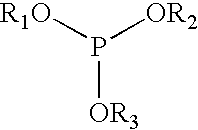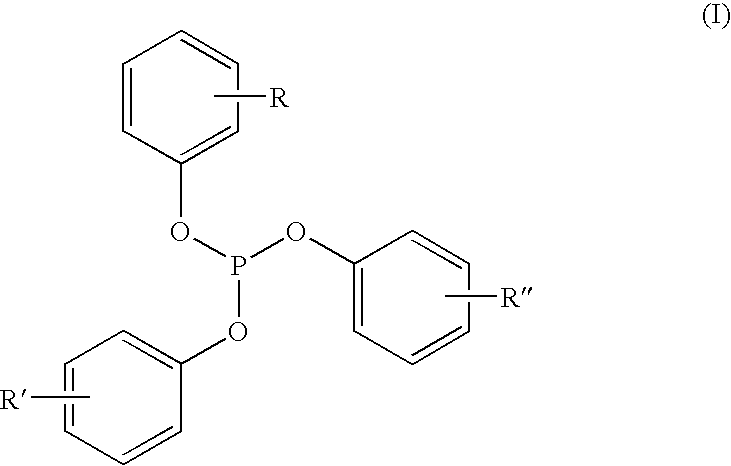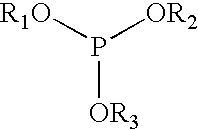Liquid phosphite blends as stabilizers
a technology of stabilizer and phosphite, which is applied in the field of new mixtures of phosphite antioxidants, can solve the problems of replacing tnpp
- Summary
- Abstract
- Description
- Claims
- Application Information
AI Technical Summary
Benefits of technology
Problems solved by technology
Method used
Image
Examples
example 1
Synthesis of Butylated Phenolic Alkylate
[0135]Phenol (188.4 grams, 2.00 moles) and Fulcat 22B catalyst (1.41 grams) were charged to an oil jacketed flask and heated to 110° C. under nitrogen. Isobutylene (180.5 grams, 3.21 moles) was added via a sintered glass frit below the surface of the phenol at a uniform rate over 4.5 hours. After the addition was completed, the reaction mass was held at a jacket temperature of 110° C. for one hour. The reaction mass was filtered and the phenolic filtrate collected. The butylated phenolic alkylate was subjected to vacuum distillation to reduce the phenol content to less than 0.25% and the water content to less than 50 ppm. Yield=290.3 grams.
example 2
Phosphite Synthesis from a Butylated Phenolic Alkylate Obtained as Per Example 1
[0136]Butylated phenolic alkylate (152.4 grams, 0.971 mole) was charged to an oil jacketed flask and heated to 85° C. under nitrogen. PCl3 (40.4 grams, 0.294 mole) was added, below the surface of the phenolics, at a uniform rate over three hours. During the addition the temperature was ramped to 150° C. The reaction mass was held at 150° C. until HCl evolution ceased, and then heated to 200° C. over one hour while the pressure was reduced from 1000 to 50 mbar. The reaction was held at 200° C. / 50 mbar until the total Cl content was less than 50 ppm. The phenolic excess was removed by distillation under one mbar pressure and an internal temperature of 250° C. (vapor temperature 145° C.). Yield=115.9 grams.
Temperature vs. Viscosity Profile for the Phosphite Mixture Obtained as Per Example 2
[0137]
Temperature (° C.)Viscosity (cSt)30366240166250494
example 3
Phosphite Synthesis from a 2:1 4-Tert-Butylphenol / 2,4-Di-Tert-Butylphenol Mixture Made Up from Phenol Components
[0138]4-tert-Butylphenol (176.6 grams, 11.18 moles) and 2,4-di-tert-butylphenol (121.3 grams, 0.59 mole) were charged to an oil jacketed flask and heated to 80° C. under nitrogen. PCl3 (73.4 grams, 0.53 mole) was added, below the surface of the phenolics, at a uniform rate over two hours. During the addition, the temperature was ramped to 150° C. The reaction mass was held at 150° C. until HCl evolution ceased, and then was heated to 200° C. over one hour while the pressure was reduced from 1000 to 70 mbar. The reaction was held at 200° C. / 70 mbar until the total Cl content was less than 50 ppm. The phenolic excess was then removed by distillation under 8 mbar pressure and an internal temperature of 200° C. Yield=279.3 grams. This product will be referred to hereinafter as Liquid Phosphite P-2.
Temperature Vs. Viscosity Profile for the Phosphite Mixture Obtained as Per Exam...
PUM
| Property | Measurement | Unit |
|---|---|---|
| pressure | aaaaa | aaaaa |
| molar ratio | aaaaa | aaaaa |
| molar ratio | aaaaa | aaaaa |
Abstract
Description
Claims
Application Information
 Login to View More
Login to View More - R&D
- Intellectual Property
- Life Sciences
- Materials
- Tech Scout
- Unparalleled Data Quality
- Higher Quality Content
- 60% Fewer Hallucinations
Browse by: Latest US Patents, China's latest patents, Technical Efficacy Thesaurus, Application Domain, Technology Topic, Popular Technical Reports.
© 2025 PatSnap. All rights reserved.Legal|Privacy policy|Modern Slavery Act Transparency Statement|Sitemap|About US| Contact US: help@patsnap.com



